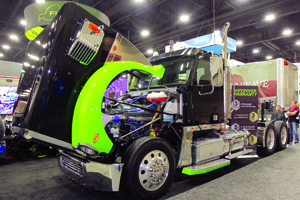GHG Comments Reveal Rift Among Industry Stakeholders

This story appears in the April 25 print edition of Transport Topics.
Federal regulators are intent on publishing the final version of Phase 2 of greenhouse-gas regulations for trucks by August, but recent comments on the proposal show an abundance of disagreement by truck and engine makers, industry and environmental advocates and manufacturers of glider kits.
The Environmental Protection Agency and the National Highway Traffic Safety Administration, the authors of the regulation, asked on March 2 for additional comments and received nearly 200 of them by the April 1 close.
A major disagreement involved the four major truck-making corporations — Daimler Trucks North America, Navistar International Corp., Paccar Inc. and Volvo Group — filing collectively against two consulting mechanical engineers, Michael Walsh and Stephen Charlton, the latter a 21-year Cummins Inc. executive who retired in 2014 from the company.
“The agencies [EPA and NHTSA] have underestimated the potential of key technologies when setting the GHG emission and fuel consumption standard for tractor engines, in particular: waste heat recovery, advanced combustion and engine downspeeding,” Walsh and Charlton said in earlier comments.
The two engineers said the agencies should have set engine standards more strict than the proposed version.
The four truck makers said in response: “The arguments in that [Walsh-Charlton] paper are highly speculative, unsubstantiated, misleading and/or inaccurate, and must not form the basis for increased stringency.”
“Setting separate engine standards based on the upper limits of advanced research would force all manufacturers to dedicate their limited resources on this with no assurance of success. Conversely, allowing manufacturers to focus on a wider variety of technologies will drive broader innovation and ultimately identify new opportunities for efficiency,” the truck makers said.
The Environmental Defense Fund endorsed the Walsh-Charlton paper.
“We reiterate our strong support for the agencies’ proposed structure of the rule — separate engine standards are imperative to drive innovative engine technology and provide proven, measurable and durable real-world emissions reductions,” said Chet France, a consultant to EDF.
“However, these benefits can only be realized through robust engine standards. Weak standards, as proposed by the agencies, do not drive advanced technologies and fall short of unlocking the full capabilities of existing technologies,” France added on behalf of EDF.
Phase 1 of GHG for heavy- and medium-duty trucks took effect in January 2014, and the second half starts Jan. 1. In February 2014, President Obama asked EPA and NHTSA to write a Phase 2 rule, and the proposal was published in June 2015.
The current form starts regulating trailers in 2018 and trucks in three stages: 2021, 2024 and 2027.
A labor union is trying to find a middle ground.
United Automobile Workers President Dennis Williams said the claim that clean air and a robust economy are mutually exclusive is a “false argument,” and there should be clean air regulations. However, he said his group does not want standards set too tight.
“We are concerned that increasing engine stringency to levels that require an unrealistic market penetration and forcing expensive and unproven technologies will significantly disrupt the market and create hardships for manufacturing workers and their families,” said Williams, whose group represents workers at Daimler and Volvo truck plants.
Williams recommended a report by Southwest Research Institute, which said waste heat recovery technology at this high cost and level of complexity is not ready for the road. He described waste heat recovery as “exotic and untried,” adding that the union wants to see the rule rolled out through 2027 and advised against acceleration up to 2024.
Daimler and Volvo maintained their positions in favor of complete- vehicle standards rather than separate truck and engine standards, but opposed each other over glider kits, with DTNA in favor and Volvo opposed.
Attorney Alec Zacaroli, representing Volvo, said some gliders serve a worthwhile purpose, but “legitimate uses should not become a loophole through which truck manufacturers are able to produce otherwise new vehicles not subject to current emissions requirements merely by installing a rebuilt, remanufactured, or otherwise non-new engine in the vehicle.”
Volvo raised numerous questions about EPA inferences on how trucks operate in hauling freight under varying circumstances and how those assumptions are plugged into EPA’s greenhouse-gas emissions model, or GEM.
“We have noted some assumption and calculation issues that impact GEM’s ability to accurately reflect vehicle operation and improvements,” Zacaroli said for Volvo.
Sean Waters, DTNA director of compliance and regulatory affairs, disagreed with the March 2 legal memo and said EPA does not have legal authority to regulate gliders under the Clean Air Act.
Comments from Navistar, written by Vice President James Spangler, also questioned the assumptions used in formulating GEM, and disagreed with the Walsh-Charlton report’s advocacy for waste-heat recovery.
“As the engine becomes more efficient to meet the proposed rule, there will, by definition, be less waste heat available to extract from these systems,” Spangler said.




